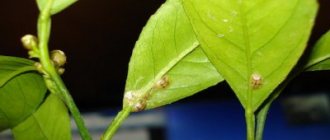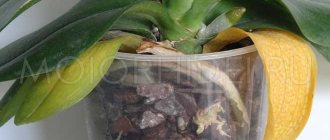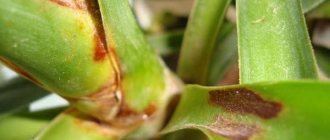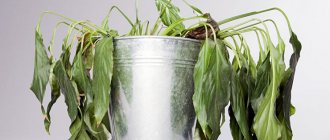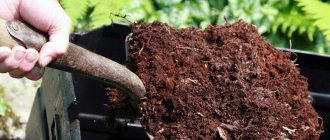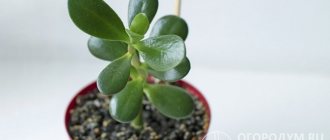Problems with hydrangea
Friends, we urgently need your help again!
My hydrangea is sick! I don’t know what’s wrong with her. It grew and bloomed beautifully in this place for 3 years. And this spring the leaves turned pale, almost yellow. I examined it for the presence of pests and diseases. There are no visual signs other than changes in leaf color! After reading magazines and searching the Internet, I decided that she lacked iron (judging by the signs). She fed her with iron sulfate. This photo was taken 2 weeks after feeding. Only the veins of the leaf acquired their natural color, but the leaf itself remained pale yellow. So that's not the problem? Anyone who grows hydrangeas and knows everything about them, please respond! It’s not a matter of soil, next to this one (60 cm, there is another young hydrangea growing - its leaf color is natural, healthy, dark green). What is she missing?
- Read all comments from the beginning:
- 1
- 2
- 3
I can’t help but share my experience of growing my favorite hydrangeas, in case it comes in handy for someone... About 5 years ago I bought a plant with the beautiful name “hydrangea” at the market, not knowing anything about it at that time... I was incredibly happy when in the spring this bush was already bloomed and produced several pink buds... A year later, the same problems began that colleagues told us about here... The plant stopped blooming... Turned yellow... In mid-April 2016, I took the risk of transplanting the plant to a new place (two steps from the old one), into a hole prepared for replanting I added a substrate for azaleas (it is also suitable for hydrangeas) ... And then I “adopted” the experience of an amateur from the city of Samara Luki and regularly water the plant with electrolyte (diluted sulfuric acid), in the ratio: 1 ml per 1 liter of water, I also spray it once a week min. fertilizer Lauren... Now the plant has pleased me with flowering again (6 buds are blooming and another one is preparing to bloom)... Yes, it is also advisable to cover the plant from direct sunlight on a hot day, because... this shortens the period of their flowering... Well, all that remains is to monitor the “well-being” of the plant and pay a lot of attention to it... But its beauty is worth it... Good luck to all lovers!
Please tell me what to do. I bought 3 blue hydrangea bushes, when I bought them the color was light blue. I planted it, the soil was initially bad, because... I planted it right under the house, and there was a lot of clay, bricks and other construction debris in the ground (I read that bricks and glass are used as drainage, which seems like a good thing for plants?), I must say that when planting, I pulled out all the garbage and changed the soil to purchased neutral in bags. I dug a hole about one and a half by one and a half meters, the old earth with bricks remained around. I applied general granular fertilizer for flowers and put wood chips on top. Pine trees grow about 3 meters from the hydrangea and, judging by the sorrel and horsetail, the soil is generally acidic. The first month it bloomed very luxuriantly, beautifully, the color changed to bright blue, then it turned a little purple. After a 2-week vacation, I discovered that all 3 bushes had turned green, I have no idea what to do? They grow in partial shade; the sun in this area appears in the afternoon and after a few hours goes behind the pines. In general, the bushes behave strangely, sometimes they fall off, apparently under the weight of the inflorescences (should we tie them up or cut off the half-faded ones?), then they stand upright. The soil is, in principle, always moderately moist, I water the bush once every couple of days, and the sprinklers work. The photo shows the whole process.
Causes of yellowing and drying of foliage
If the leaves of a hydrangea turn yellow, it does not matter whether it is indoors or outdoors, the reasons for the appearance of a negative symptom should be sought in adverse external influences or damage to a fungal and sometimes viral disease
As sad as it may be, often the prerequisite is illiterate care of the plant and violation of the rules for its maintenance.
One of the important factors influencing the state of culture is the lack of light. Since hydrangea prefers good lighting, it should not be placed in shaded areas. A little shading is allowed, which makes the light diffuse, but this does not mean that the plant should be in the shade all the time. The minimum number of daylight hours for this decorative species is 6-8 hours a day, otherwise its foliage may turn yellow. This is due to the important processes of photosynthesis and chlorophyll formation. Another reason is cold air and the presence of drafts, and this applies not only to home hydrangeas, but also to vines, tree and shrub varieties of hydrangea. Lovers of different varieties are well aware of the moisture-loving nature of the crop, but if there is stagnation of water in a pot or open soil, its lower leaves will gradually turn yellow and may fall off in the future. And it’s not just a matter of abundant watering - outdoor garden shrubs and trees can be flooded during the rainy season or one, but powerful downpour. Dry soil is no less dangerous for a crop, which is why experts advise relying not on a diary, which indicates watering dates, but on personal checking the condition of the soil. Also, the danger to the health of hydrangea lies in sudden changes from dryness to abundance of moisture.
A plant that has been without water for one reason or another for a long time must be watered moderately and carefully, otherwise it may show all the signs of disease. If a plant blooms long and luxuriantly, this process itself depletes it. If the vital activity of hydrangea is not supported by competent agricultural technology and fertilizing compounds, then already in the middle of the flowering period it can turn yellow
The explanation for this is simple - hydrangea devotes all its strength, nutrition and energy to reproduction - the formation of flowers and the further formation of seeds. Of great importance in the development and growth of ornamental varieties is the nutrition received by the above-ground part from the root system, and it directly depends on the quality of the soil and the substances contained in it. When the edges of the leaves turn yellow and dry out, this is the first sign indicating a lack of iron and nitrogen in the soil. There are other issues directly related to the composition of the soil and the deterioration of the hydrangea. This flowering species prefers slightly acidic and acidic soil, with a pH value of 3-6 units. The presence of an increased amount of alkali does not allow the roots to normally absorb useful elements, and, of course, this cannot but affect the appearance of the plant.
For shrub hydrangeas growing in the garden, the problem often arises due to inaccurate transplantation, including when dividing
Sometimes it is difficult to carefully dig up the roots and they are damaged by mechanical action
Features of growing hydrangea
When growing hydrangeas, emphasis is placed on:
- The plant's love for water. Translated from Latin, Hydrangea means “a vessel filled with water.”
- Soil acidity level – pH 5.0. For hydrangea, acidic soil is preferable. The presence of lime in the soil in large quantities is not to the liking of the plant. The tree type is more tolerant, but you should not abuse it to get good flowering.
- Loose, fertile soil and regular fertilization affect the development of hydrangea.
- Varieties that bloom on the shoots of the current year - the bushes are pruned only in the absence of vegetation.
- To the location of the hydrangea. In areas with hot summers, water-loving hydrangeas like partial shade. Only certain varieties bloom in a sunny place, however, with periodic and abundant watering in dry conditions. Punctures when cultivating hydrangea are often associated with an unfavorable soil reaction for the crop. The plant requires an acidic microenvironment. Petiolate and large-leaved hydrangeas also grow in central Russia.
- Crown formation. To obtain a leafy and flowering shrub, the apical shoots of the crop are pinched.
- Temperature conditions. Hydrangea is successfully grown indoors at a temperature of +12…+18 °C. They prevent the bush from freezing: the hydrangea is removed for storage in a timely manner in the fall. Bring it to a dark and cool place. A week-long stay in the dark will result in the fall of frozen leaves. Later, the hydrangea is stored in the cellar until spring.
- Apical buds. It is important not to damage during storage - they ensure luxurious flowering. If the soil in the pot dries out, watering once during the storage period is enough.
Color Changing Technology
Start of the process
Before you start painting hydrangeas, you need to determine the acidity of the soil. To do this, use special means or turn to folk methods. If you want to have hydrangeas of different shades, experienced gardeners recommend growing them in different containers. This makes it easier to maintain the soil acidity required for each color.
Hydrangeas in pots
Soil testing
Sometimes the soil does not need to be tested. The appearance will tell about its properties:
- red tints on the surface, reminiscent of rust, indicate that it is highly acidic;
- after watering, a film forms on the water, which shimmers in the sun, which means the reaction is acidic.
If there is a device that allows you to determine the exact value of soil quality, then you can predict the color of the plant in the future. Provided no additional funds are deposited:
- pH about 7.5 – bright pink inflorescences;
- pH less than 4.5 – a blue tint will remain or appear;
- pH in the range from 5.5 to 6.5 - the flowers will become purple or pink and blue on the same bush at the same time, you will get colored hydrangea.
Application of drugs
There are several ways to change soil acidity:
- When planting, add acidic peat, for example, pine bark, to the top layer;
- Feed with special fertilizers that acidify the soil;
- Mulch with peat and pine needles. This means that you need to add these materials to the surface of the soil in order to change its properties in this case. Thus, mulching is also used to protect against pests and diseases, and not only natural materials are used, but also artificial ones, which are crushed to the desired size.
Prevention
How to care for a plant so that it does not become weak? Preventive measures are the best way to combat various plant diseases of flora and fauna.
To prevent green leaves from changing color, follow these rules:
- adhere to the water regime: try not to flood or dry out the hydrangea;
- water the bush with soft, settled water;
- expose the plant only in a warm room where there are no drafts;
- avoid exposure to the sun's rays on hydrangea foliage;
- In order for the leaves to turn lushly green, summer residents remember to periodically feed them.
- carry out antimicrobial and antiviral treatments.
Following the recommendations prevents yellowing of foliage and helps maintain beauty for a long period of time.
How to revive yellowing foliage
When the leaves change from greenish to yellowish, you will need to take adequate measures to heal the hydrangea, otherwise the bush will die. It is useful to establish the causes of the disease and select appropriate methods of therapy.
When a bush dries out, they try to restore it. When hydrangea grows in the garden, with the arrival of spring, the frozen areas are cut out. When a crop is affected by rot, pruning will have to be done 1 cm below the infected area. The cutting area must be sprinkled with ash or activated carbon. The pruning shears must be disinfected after the procedure. The shrub is treated with fungicides, depending on the phytodisease.
How to revive hydrangea
To revive a hydrangea from a vase from which you need to remove a flower, you need to cut off the lower part diagonally and immerse the plant in a steep pitch for 3-5 minutes. When air bubbles stop coming out of the stem, remove the hydrangea from the liquid, cut off the part that was in boiling water, and place the plant in cold water. Manipulation will add charm and elegance to the flower.
Often, hydrangea awakens from winter hibernation weak; as it grows, one notices crushed foliage with veins like steel. The lack of nitrogen is compensated for by foliar spraying of the crown with ammonia. Top dressing is prepared from 2 tbsp. l. ammonia, which is dissolved in 10 liters of water. 1-2 procedures are enough.
Diseases that cause whitening of leaves
There are a lot of diseases that, if not properly cared for, can harm hydrangeas and lighten its leaves.
Ascochyta blight on hydrangea
- Powdery mildew
The appearance of a gray coating on the bottom of the leaf indicates that the hydrangea is infected with powdery mildew. The upper part becomes spotted and later turns brown.
You can save the flower with the help of Fitosporin (at an early stage) or Topaz (in a neglected state).
Gray or white rot appears as a change in the color of the leaves. The hydrangea is literally all covered with gray or white spots, the leaves dry out and completely crumble.
You can save the plant with a solution of Bordeaux mixture or copper sulfate.
Externally, the disease manifests itself in the form of spots that instantly grow. The irregularly shaped circles are colored yellow-brown and framed by a dark border. With a prolonged course of the disease, the leaves fall off completely.
Fungicides are used to combat the disease.
Why do hydrangea leaves turn pale?
Summer residents usually have a lot of questions about how to properly care for hydrangeas. Particularly relevant is the problem of why hydrangea has pale leaves and how to deal with it.
The aboveground part of the plant can change color for several reasons, but the most common is a lack of nutrients in the soil. In order for the hydrangea in the country to regain its attractive appearance, you need to properly fertilize the soil or apply fertilizer before planting.
Hydrangea leaves are turning lighter - what to feed?
Many gardeners have a question: if a hydrangea has pale green leaves, what to do and how to help the flower? First you need to determine the composition of the soil, and only then begin to solve the problem - select fertilizers for this case.
Hydrangea in the garden
Note! Soil acidity should range between pH 4.0 and 6.5. If the alkaline environment increases, then the balance needs to be restored.
If the leaf blade begins to turn white, but the veins retain their original color, then a disease such as chlorosis is determined. It is advisable to immediately begin to restore the normal composition of the earth.
When hydrangea leaves lighten, how to feed the soil to restore the plant:
- When acidity decreases, it is enough to dilute ¼ of a tablespoon of citric acid in a bucket of water. Water the soil under the bush with the solution.
- Until mid-summer, it is recommended to apply fertilizers containing iron or nitrogen once every 2 weeks.
- Before the flowering period, you need to apply organic fertilizers (humus, manure) every month and water them twice with water and mineral fertilizers.
The quality of the bush, if all conditions are met
If nutrients are not added, the shoots may turn completely white. Additionally, the buds will dry out.
Diseases
Hydrangea diseases that can lead to leaf discoloration primarily include powdery mildew. If this is the case, then the plate becomes covered with a white coating. The disease is caused by high humidity in the air and soil.
Control methods include eliminating the affected leaves - they are pinched off and burned. Next, the bush is treated with fungicides. These include “Alirin-B”, “Topaz”, “Chistotsvet”. The exact selection of the drug is made based on the degree of damage to the bush.
Detection at an early stage allows you to get by with a homemade product. To prepare it, you should dissolve 15 g of copper sulfate and 150 g of laundry soap in a bucket of water.
What does hydrangea like?
To grow a beautiful flowering bush without problems, it is worth finding out what a certain variety of hydrangea likes. This applies not only to fertilizer, but also to the planting site, which significantly affects the condition of the plant:
- The plant loves abundant watering, which is carried out at certain times of the day. The regime is very important for this culture. The indoor species also likes abundant irrigation.
- Garden and indoor varieties adore the sun, so it is recommended to display flowerpots and plant plants in open areas. Dark corners and serious shadow are not at all suitable for this flower. It is better to choose a bright corner in which the hydrangea will show its best qualities.
- There shouldn't be a lot of light at midday. Some structure or plant must create partial shade.
Important! If the soil is low in acidity or the buds get a lot of light, the flower may turn white.
The most difficult thing in caring for a flower is maintaining the watering and fertilizing regime. Other factors are of little significance for the normal development of culture.
Feeding hydrangea with kefir
Experienced florists feed hydrangeas with kefir 2-3 times a month. This version of “food” is the flower’s favorite delicacy because it contains lactic acid bacteria.
What to feed
To avoid nutrient deficiencies, apply a balanced fertilizer for flowering shrubs in the spring. The content of nitrogen, phosphorus and potassium should be the same. Check the application rate on the fertilizer packaging, and then apply it monthly in spring and summer.
The simplest remedy for nitrogen deficiency is to add ammonium sulfate to the soil (150 g/1 m²). It can also be scattered around the hydrangea or applied as a water solution. There are many reasons why hydrangea leaves turn yellow. But they are all easily eliminated. And if you follow simple rules for caring for these flowers, then hydrangeas will always remain lush and blooming.
Why do hydrangea leaves turn red?
There are several reasons why hydrangea leaves turn red and shoots may wither:
- Too much watering, which is accompanied by the use of the wrong water - too hard.
- A lack of nutrients or an excess of them can worsen the situation regarding spoilage of the aerial parts.
- Violation of the root system leads to reddening of the leaves. It is necessary to periodically water the plant with special fertilizers.
- When the leaves turn red and begin to dry, it is worth removing the pot with the plant from the draft. Sometimes you have to change the location of the bush.
Red leaves of hydrangea
The cause of changes in the pigmentation of the aboveground part can be any violation of the regime of watering, fertilizing, or lighting.
What to do if leaves curl and dry out due to chlorosis
Sometimes hydrangea leaves curl due to chlorosis, what should you do in this case? Signs of chlorosis are yellowing of the leaves, but the veins remain a natural green hue. They curl and dry out, eventually dying completely and falling off.
When such a problem occurs, hydrangea is carefully treated with preparations that contain iron. For this purpose, Atichlorosis is used. Among the folk methods, treatment with a solution of iron sulfate works well. You can water not only the soil, but also spray the bush itself.
Note! After treatment is completed, as a preventative measure it is recommended to water the plant with a weak solution of citric acid.
Why do hydrangea leaves turn black?
A good gardener knows that hydrangea rarely suffers from viral or fungal diseases. But if this happens, the leaves begin to turn black in different patterns.
The leaves of the flower begin to turn black
Leaves and stems will first darken and then turn black due to the following problems:
- White rot affects the roots and then spreads to the stems.
- Gray rot first appears as rotting, tight spots.
- Downy mildew first attacks the stems in some areas.
- Septoria disease appears as brown spots that later turn black.
To get rid of pests, fungi or infections, it is recommended to spray the flower with copper sulfate - this is a universal fungicide.
Additionally, foliage may turn black due to hard water. The formation of voluminous black spots can occur due to sunburn.
Preventive measures
Better than any treatment is timely and correct prevention. If the bush is healthy, it is unlikely to get sick, but if this happens, the hydrangea will be resistant to disease. A weakened plant is very vulnerable to viruses, fungi or pests that can seriously harm it.
Proper care at home will help prevent diseases and protect against pests. For a healthy flower, it is necessary to correctly determine the place for its planting. Under the scorching sun, foliage and flowers quickly wither. Therefore, it is optimal for hydrangea to grow in partial shade.
Sufficient watering is also important for the plant.
Hydrangeas prefer moisture, so it is important not to let the soil dry out. In hot weather, you need to water the bush every other day.
It is also important to choose the right soil for planting hydrangea bushes. The plant will have a hard time surviving in heavy alkaline soil.
It needs to grow in light soil with an acidic environment. It is this kind of soil that “breathes” well and allows moisture to pass through.
Providing proper and timely feeding is also necessary for hydrangeas. For this, special ready-made nitrogenous fertilizers are useful. In the summer, phosphorus-potassium agents are used, and in the autumn season, phosphorus agents are mainly used.
Shrub wood also needs preventative treatment. In the spring, before the growing season begins, it is recommended to irrigate the bushes with copper sulfate. As a replacement option, use “Topaz”, “Iskra” and “Fitosporin” - the most modern effective drugs.
For more information about diseases and pests of hydrangea, see the following video.
How to save garden hydrangea
To save a plant from death, you need to know a few secrets of flower restoration:
- Treatment should be carried out immediately after the problem appears.
- Each damaged leaf must be cut from the stem.
- Fertilize the specimen immediately after treatment with a special product.
Each variety has its own distinctive features in terms of the possibility of survival, but the principle of “salvation” is common to all. The care instructions are not complicated or problematic.
Various pests discoloring leaf blades
When a plant is damaged by a spider mite, the leaves turn yellow and dry out completely. An untimely response may result in the death of the flower. You can cure a damaged plant using pesticides.
If the leaves turn black, then most likely, upon inspection, you can detect harmful aphids. The insect covers the plant with sticky sap, which becomes the basis for the immediate development of a fungal disease. Pollinating a flower with tobacco dust will be a great help and will save the plant in a short time.
Hydrangea does not wake up in spring - what to do
Planting tree-like hydrangea in open ground in spring is accompanied by one advantage - the plant will definitely take root and bloom in the summer. But specimens that overwintered (they had to be opened) may not show signs of life for a long time.
Not revived hydrangea
The question arises, if hydrangea does not wake up in the spring, what to do with such specimens? There are several options that experienced gardeners use.
How to revive hydrangea
There are several ways to revive a bush in the spring if it does not send out young shoots:
- It is necessary to remove those parts that are damaged by pests, diseases, and frosts.
- Planting old bushes gives good results. You can use several options - dividing the bush, cuttings.
- Anti-aging and sanitary pruning also have a beneficial effect on the condition of the depressed specimen.
The flower can come to life from several days to 1 month. If during this period there have been no changes in condition, then it is better to get rid of such a bush. Reproduction of such an instance will not give any results.
Do I need to prune hydrangeas for the winter?
Before you begin preparing for the winter, you should find out whether you need to prune your hydrangea for the winter. It is advisable to reduce the volume of the bush before building a shelter house. Thanks to the smaller area of the shoots, the risk of frostbite, drying out and mechanical damage will also be reduced.
Attention! Each variety is pruned according to a specific method - it is better to study the recommendations specific to individual varieties.
Using popular tools
Each method deserves special attention:
- Lemon acid. To obtain a solution, you need to mix 12 liters of water with 1 tsp. citric acid. Watering is carried out every 25-30 days to maintain the optimal acidity level. An alternative is to use lemon juice.
- Table vinegar. Use 9% essence, which is diluted in water in a ratio of 200 g per 20 liters. The method allows you to acidify the soil, but the effect is short-lived. It has been noticed that the use of vinegar negatively affects the soil microflora.
- Succinic acid. The use of this drug not only increases the acidity of the soil, but also serves as a fertilizer for the plant. The solution is prepared at the rate of: 3 tablets per 1 liter of water. If the drug is purchased in a different form, then you should adhere to the proportions on the package in order to feed the flower and not harm it.
- Apple vinegar. The solution is prepared from a bucket of water and 1 tablespoon of vinegar. Acidify the soil no more than once every 3-4 months. It significantly increases acidity and is less harmful than table vinegar. This acidifier still has a negative effect on the soil.
- Oxalic acid. Once every 1-2 months, watering is carried out with water containing oxalic acid, which is added in a ratio of 100 g per 10 liters. It is advisable to first dilute the required amount of crystals in a glass of warm liquid, and then add this solution to a bucket of water.
Popular means for soil acidification
Most gardeners prefer to use succinic and oxalic acid. Citric acid is often used for hydrangea. Vinegar is used less frequently due to its negative effect on the state of soil microflora. How to water hydrangea with vinegar and whether it can be done - each gardener decides for himself.
Note! It is important to strictly observe the proportions for preparing solutions. Failure to comply with them can lead to deterioration in the condition of the plants.
Improper care
Most often, the reasons why hydrangea leaves turn yellow are due to improper care. Changes in the color of leaf plates may be associated with the following factors:
Overwatering. Hydrangeas are moisture-loving, but in moderation. If too much water enters the soil due to heavy watering or prolonged rains, the delicate ornamental shrub will begin to “sick,” which will manifest itself in yellowing of the foliage and its subsequent dropping. Lack of heat and drafts. Yellowing of leaves for these reasons is typical not only for ornamental shrubs grown at home in pots. Garden hydrangea can also suffer from a lack of heat and drafts if it grows in a region characterized by a small number of sunny days and constant winds. Nutritional deficiency. During the growing season and decoration, hydrangea requires a constant supply of fertilizing
If your garden beauty does not receive fertilizers and grows on its own, without your care, the yellowing of the foliage, inferiority and weakness of the bush will be completely explained by your insufficient attention to it. Most often, a change in the color of the tips of the leaves accompanies a state of nitrogen and iron deficiency in the soil. Incorrect lighting
Hydrangea does not like open places; it is more comfortable for it to grow in areas with diffused lighting. If the bush is located in strong shade or under constant direct sunlight, its foliage will expectedly change its green color to yellow. Lack of strength. In varieties characterized by abundant and lush flowering, the leaves may begin to turn yellow during the decorative period. This happens due to the fact that the bush simply does not have enough strength to “stretch” the maintenance of flower stalks and green mass. Like any other plant, hydrangea devotes all its energy to reproduction, that is, it sends food to the flowers, in which seeds should form. Incorrect transplant. If you recently dug up a hydrangea and moved it to a new location, and then its foliage began to turn yellow, you may have damaged the root system. With proper care, it will recover and get stronger over time. Alkaline soil. The ornamental shrub loves acidic soil from 3 to 6 PH, but in alkaline conditions the hydrangea root system begins to poorly absorb nutrients, which is manifested primarily by yellowing of the foliage.
You can identify the true cause by carefully examining the place where the hydrangea grows. Assess whether the soil is too waterlogged and whether the shrub is located in constant shade.
Correcting the situation
So, you have determined the true cause of the yellowing of hydrangea leaves, what to do now? Action should be taken immediately to help the ornamental shrub recover before the onset of cold weather.
If the cause is excessive moisture, temporarily stop the flow of water into the soil, and subsequently reduce the frequency of watering. Feed your garden beauty according to a standard schedule: treat it with nitrogen-containing preparations in early spring, and sodium, phosphorus and potassium in June and July.
Also, do not forget to periodically alkalize the soil, especially if the water in your area has lime impurities. To do this, gardeners usually use solutions of lemon juice or vinegar, and in case of iron deficiency, a solution of ferovit.
Choose a comfortable place for the ornamental shrub, where it will be illuminated by diffuse sunlight, and the root system will not suffer from waterlogging.
To maintain the strength of hydrangea, which may have suffered due to damage to the roots, it is recommended to water the trunk circle with Zircon once a month.
Overgrown or abundantly flowering shrubs, which do not have enough nutrition to support all processes, need timely pruning.
Inspect the hydrangea and remove some of the young or losing decorative inflorescences, and also trim off excess branches. This measure will allow the shrub to optimally use the nutrition it receives for peduncles and green mass.


